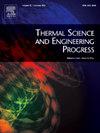Structural damage of CRTS II slab ballastless tracks induced by temperature distribution on viaduct-tunnel transition sections
IF 5.1
3区 工程技术
Q2 ENERGY & FUELS
引用次数: 0
Abstract
This paper investigates the structural damage of the CRTS II slab ballastless track incurred by the longitudinal temperature gradient on viaduct-tunnel transition sections. Initially, the study characterizes the temperature distribution of the track on these transition sections using field measurement data. Subsequently, a numerical model representing the nonlinear mechanical properties of slab ballastless tracks on the transition section is developed and validated. The study analyzes the mechanisms of interfacial damage, encompassing interfacial debonding and separation. It also examines the impact of post-installed reinforcement on mitigating track damage on the transition section. Key findings include: 1. Under identical environmental conditions, the longitudinal displacement of track slabs on the transition section can reach up to 81% higher than that of slabs situated on the viaduct. 2. The longitudinal temperature gradient on the transition section can cause coordinated longitudinal movement of multiple slabs and potential splitting of interfaces between structural layers. 3. On the transition section, the vertical displacement of track slabs reinforced with post-installed anchors can be reduced to approximately 45% of that without anchors, highlighting the effectiveness of the anchors. These findings provide valuable insights into the mechanical behavior of tracks on viaduct-tunnel transition sections and offer practical guidance for selecting appropriate track maintenance measures.
求助全文
约1分钟内获得全文
求助全文
来源期刊

Thermal Science and Engineering Progress
Chemical Engineering-Fluid Flow and Transfer Processes
CiteScore
7.20
自引率
10.40%
发文量
327
审稿时长
41 days
期刊介绍:
Thermal Science and Engineering Progress (TSEP) publishes original, high-quality research articles that span activities ranging from fundamental scientific research and discussion of the more controversial thermodynamic theories, to developments in thermal engineering that are in many instances examples of the way scientists and engineers are addressing the challenges facing a growing population – smart cities and global warming – maximising thermodynamic efficiencies and minimising all heat losses. It is intended that these will be of current relevance and interest to industry, academia and other practitioners. It is evident that many specialised journals in thermal and, to some extent, in fluid disciplines tend to focus on topics that can be classified as fundamental in nature, or are ‘applied’ and near-market. Thermal Science and Engineering Progress will bridge the gap between these two areas, allowing authors to make an easy choice, should they or a journal editor feel that their papers are ‘out of scope’ when considering other journals. The range of topics covered by Thermal Science and Engineering Progress addresses the rapid rate of development being made in thermal transfer processes as they affect traditional fields, and important growth in the topical research areas of aerospace, thermal biological and medical systems, electronics and nano-technologies, renewable energy systems, food production (including agriculture), and the need to minimise man-made thermal impacts on climate change. Review articles on appropriate topics for TSEP are encouraged, although until TSEP is fully established, these will be limited in number. Before submitting such articles, please contact one of the Editors, or a member of the Editorial Advisory Board with an outline of your proposal and your expertise in the area of your review.
 求助内容:
求助内容: 应助结果提醒方式:
应助结果提醒方式:


